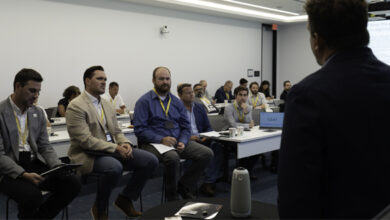Drilling programs give university students hands-on exposure to automation, simulation
School projects prep future engineers to work with big data, champion innovation
By Kelli Ainsworth, Editorial Coordinator

A growing number of universities, research institutes and oil and gas industry groups are investing in programs that put students in front of the industry before they graduate. Three such programs are the Rig Automation Performance Improvement in Drilling (RAPID) at the University of Texas at Austin (UT); Drilling Simulator Celle, affiliated with Clausthal University of Technology in Germany; and the Drillbotics competition sponsored by the SPE Drilling Systems Automation Technical Section (DSATS).
Not only do these programs give students early opportunities to practically apply what they learn in the classroom, they also teach them critical skills needed in the workforce. These include teamwork and collaboration skills, said Dr Eric van Oort, Consortium Director for the RAPID program at UT’s Cockrell School of Engineering. “Teamwork is extremely important, and it’s much better if they learn about it in university. They’re much better prepared for the industry.”
As drilling rigs become more automated, universities and research institutes are following along, not only by studying automation but also by producing graduates who are experienced and comfortable with designing automated systems. “The landscape of well engineering skills is rapidly changing. We are training the well engineers of the future,” Dr van Oort said. “Students need to have been trained in a multidisciplinary way with traditional drilling and completions skills but also with a very healthy understanding of automation and data analytics.”
Data-driven drilling

In May 2015, after three years of preparation by Dr van Oort, UT formally launched the multidisciplinary RAPID program, which is tasked with studying and advancing drilling automation technology. Dr van Oort had previously led Shell’s drilling automation program before entering academia full-time in 2011. He said he was driven to carry over his focus on automation into an educational setting in order “to improve efficiency from a manufacturing standpoint, to be able to do tasks in a more efficient way and to take people out of harm’s way.”
Professors and graduate and undergraduate students from across multiple disciplines, including mechanical, petroleum, aerospace and computer engineering, are being invited to participate in the consortium’s research. Student members of RAPID enroll in a multidisciplinary academic track, taking courses from mechanical and petroleum engineering and computer science “to give them the background that the automation drilling engineers of the future will need,” Dr van Oort said. Projects assigned in these classes are connected to RAPID’s R&D activities, which focus on applied, rather than abstract or purely theoretical, research. “We do research with the intent of delivering something that can ultimately be applied and that can ultimately be put into a well or into a machine and add real value.”
Because the program was only recently launched, no projects have been completed yet. However, the program will provide students with several avenues to get involved in automation projects. Teams of up to 10 undergraduates can work on a senior design project, in which they’re presented with a problem the industry is facing and are tasked to come up with a unique solution. For example, students may be asked to work on automated pipe doping. “They might interact with a rig contractor to find out what pipe doping is and how it needs to be done,” Dr van Oort said. RAPID expects to sponsor several such projects this year.
For graduate students, the program plans to take on six projects this year covering a range of technologies, such as drilling simulator downhole model design and drilling fluid automation. “We work on all different kinds of things that are important to the industry, from vibration mitigation to drilling fluid automation to automated wellbore stability and managed pressure drilling.”
At the 2015 SPE/IADC Drilling Conference, five UT petroleum engineering graduate students presented papers based on projects that were conducted in preparation for RAPID, he added. These papers also demonstrate the sort of projects in the pipeline, and Dr van Oort said work from these projects will be carried forward under RAPID.
A real-time operations center (RTOC) located on the UT campus will figure heavily into RAPID projects, as well. Dr van Oort believes it is the only such drilling RTOC in academia. “We can actually stream historical and real-time well data into the RTOC and have students analyze that data and look at how efficiently wells are being drilled and what are potential opportunities for improvement,” Dr van Oort said.
Recently, an independent operator turned over a year’s worth of historical data from six rigs to the RTOC, while also providing the RTOC with three months of real-time data from the same rigs. When students analyzed the data, they found $57.5 million in potential savings, Dr van Oort said. “The students identified a range of performance operational excellence opportunities, ranging from reducing unnecessary bit runs due to bit damage from drillstring vibrations to improving horizontal well quality by characterizing and reducing well tortuosity.” While this particular project was not done under RAPID, similar research will be done through the program.

Going forward, improving both the quality of data and the industry’s use of it will be a major focal area for RAPID. “The future of drilling is data,” Dr van Oort said. “There’s tremendous value in data, and people are starting to realize that now.” In the past, companies have paid for data acquisition but then done nothing with the data they received. However, he sees that changing. Today’s students, who have grown up with an abundance of information in the palm of their hands with smartphones and tablets, are particularly prepared to work with big data. “Students are primed for that. They love sophisticated software tools, and they’re wizards at working them.”
Exposing students to the industry through programs like RAPID can shorten the learning curve when students transition from an academic environment to a professional one, Dr van Oort believes. “Often students get good academic training, but industry hires them and basically has to retrain them at a considerable investment. Anything we can do to cut down on that time and have students be productive earlier is going to be of phenomenal importance to the companies.”
Further, students who have worked with automation at the university level can champion the uptake of new automation technologies at the companies for which they go on to work. “My students are going to join companies and ask questions about why companies haven’t adopted certain automation practices or data analytic routines,” he said. “That’s going to change the industry.”
Funding for RAPID comes from the industry, with companies paying a membership fee to access research data and results. Companies can also participate by sponsoring specific projects or by making their tools, equipment and software available to RAPID for use in its research.
Drilling from A to Z
The government of the German state of Lower Saxony has funded a $10 million research center in Celle called Drilling Simulator Celle (DSC). The center, affiliated with the Clausthal University of Technology, will “represent the drilling process from A to Z,” said Joachim Oppelt, head of the department of Drilling and Production at the university.
Once the DSC becomes fully operational in 2016, it will house installations for testing both hardware and software systems. “Testing opportunities will be very broad,” Mr Oppelt said. These include everything from simple downhole flow tests to downhole tool dynamics characterization, and from testing process simulation software to testing drilling rig automation components. “What we have here is the full simulation of a rig,” he said.
The primary purpose of the software simulator, Mr Oppelt said, is to allow researchers to better simulate and model the drilling process. “Our main interest here is to improve the software that is used to represent the drilling process and problems that occur sometimes,” he said. “When you understand why you have certain dysfunctions, you can get ideas on how to solve the problem.” For a fee, outside companies will be able to bring in their own hardware components, software models and surface computer equipment for automation to be tested on the simulator, he added.
DSC’s hardware simulator, due for installation in Q2 2016, will consist of all of the fluid installations typically found on a rig, including mud pumps and circulation equipment, as well as a pressurized test chamber to simulate regular operating conditions. “Even though we don’t have all the infrastructure there yet, there will be enough in place to do our first job for a service company in September,” Mr Oppelt said.
The hardware and software simulators can run individually or be linked together. If linked, data coming from tests performed in the hardware simulator can then be used as real-time input data for the software simulator. Mr Oppelt believes that this ability to run the hardware and software simulators independently or as an integrated system is what sets the DSC apart from other drilling simulator facilities. “We think that with the combination of the hardware and software simulators, a lot of drilling automation development can take place here,” he said. “That’s actually the core area where we think we’ll be working.”
Looking ahead, Mr Oppelt envisions that students at Clausthal University of Technology will eventually be able to conduct research for their master’s thesis at the DSC. The center is also exploring the possibility of introducing a continuing or extended education program in the long term. Although the shape of such a program has not yet been defined, one possibility is creating a program that can train technical employees from industry companies for managerial positions. “We could have something that is a mix between management and technical skills to prepare them for higher levels of responsibility,” he said.
Automation in action
In 2014, DSATS sponsored its first Drillbotics competition. Drillbotics gave teams of university students the opportunity to design and build a scaled automated drilling rig. The purpose of the competition, said Rig Operation President Fred Florence, who chairs the DSATS University Drilling Competition Subcommittee, was to attract new engineers to the industry with a specific interest in automation. “We see creative people that can work in a team that understand something about automation that their fellow students don’t understand,” he said. “A number of the DSATS members recognize that this is a tremendous recruiting tool. These are the students we want to hire.”
The inaugural competition began in fall 2014, when four participating teams, each with four to five students, began designing their rigs. The teams were composed primarily of graduate students across a range of disciplines, including petroleum, mechanical and electrical engineering and computer science. Participating universities were Texas A&M, the University of Texas, the University of Oklahoma and the University of Agder in Norway. Designs were submitted by 31 December, and teams then spent the spring semester building their rigs.
DSATS gave the teams a great deal of flexibility in their designs. While DSATS supplied the equipment for drill pipe and bits, as well as a sample formation that the rigs would eventually drill, every other element of the rig’s design and construction was left to the teams. Each team was limited to a $10,000 budget and was penalized if they went over it. Working within the budget required teams to consider efficiency and cost trade-offs, Mr Florence said. “They had to make these tough engineering decisions that are, for a student, pretty difficult. In the real world, it’s what we deal with everyday. We’re trying to show them what’s coming after they graduate.”
DSATS also deliberately put other hurdles in the teams’ paths to test their adaptability and problem-solving skills. For example, it changed the drillstring criteria in March, only two months before the completion deadline. “They weren’t happy with that, but I told them that’s the way our world works in the drilling industry,” Mr Florence said. “Somebody comes up with a new type of drill pipe after you’ve already built the autodriller. You have to be prepared and flexible for those changes.”
In May, DSATS members visited the four participating universities to evaluate the rigs. Teams had to demonstrate how their rigs drill into a sandstone-granite-sandstone formation. The main judging criteria were safety, efficiency, creativity and practicality. A feature many of the teams came up with, and with which DSATS was pleased, was a drawworks with both push and pull capabilities. This technology is used in the industry today but is not commonplace. Typically, autodrillers only release the line, but if a particularly hard formation is encountered and the autodriller has too much weight on the bit, the driller has to intervene and manually come off bottom. “If you have a push-pull drawworks,” Mr Florence said, “then the machine itself can just pick the bit up a little and change the weight setting. The teams that saw that came up with a better design.”
There were also obstacles encountered by all the participating teams. Every team had a pipe failure in the harder portions of the formation, Mr Florence said. DSATS intentionally gave the teams a pipe that was prone to failure to see how the teams would handle it.
Although all the teams ultimately experienced this failure, the team from the University of Oklahoma was able to better recognize that the pipe was prone to buckling and that, if they pressurized the pipe, it would be more resistant. The OU rig also controlled drillstring motion and vibration better than the other teams and designed a rig that could rig up and down easily. For these reasons, Mr Florence said, the OU team was declared the winner. Texas A&M University took second place. The student teams are now each preparing papers based on their learnings from this project to present at industry events throughout fall 2015.
All of the participating teams benefit from hands-on projects like Drillbotics. Seeing the positive results of creative changes early on may lead to future industry leaders who are more likely to embrace innovation, Mr Florence said. “Here are some young engineers who realize what does work and doesn’t work in drilling automation,” he said. “When they move into an operational role, they will know more about it and won’t fear change like some other people do.”
DSATS deliberately kept Drillbotics small for the 2014-2015 academic year as it was the inaugural competition. For the 2015-2016 competition, a total of 50 schools have been invited to participate, and the committee is particularly focused on recruiting outside the US. Participating teams for the 2015-2016 competition will begin designing their rigs early in the fall semester. Once again, designs will be due to DSATS on New Year’s Eve. Following the committee’s review of the designed, finalists will be chosen to move on to the next round and build the rigs. In April and May, the finalists will perform demonstrations for DSATS members with their completed rigs. Following these demonstrations, the winner will be announced.
Click here to view a video interview about the Drillbotics competition.




